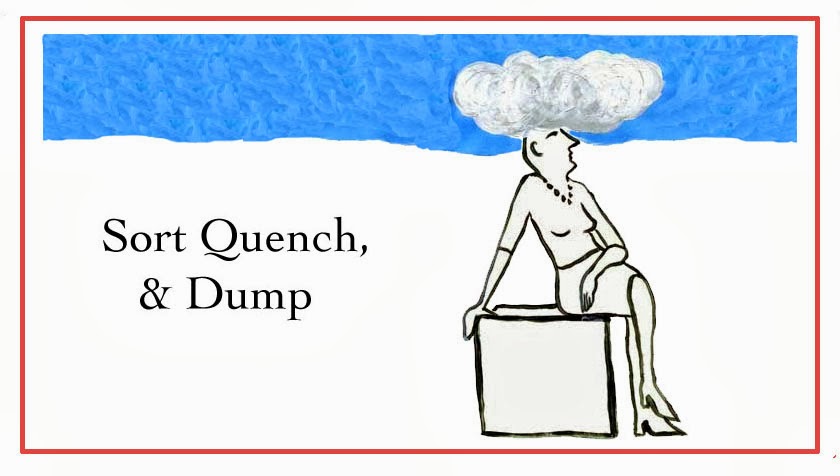A project is a good thing to have.
A project can keep those demonic lost memories in their demonic cages. And also because I have a tendency to get antsy, and because it seems like a good thing to do before it is too late, I have embarked on the project of translating
Les Sept Faux Departs with my mother. French is after all her native tongue. In the past few years, while sorting through the sedimentary memorabilia that buttresses my parents’ home, I found this thick bound volume written by my grandfather in the 1940’s. All 346 pages are handwritten, elegantly and legibly, in French, and the whole is bound in red leather.
I thought that as we translated I would learn the details of the family’s sorrowful wartime separation, along with some French vocabulary.
There are many things we do not know about our parents and grandparents. That is normal and unless one is obsessive and weird, it is also completely desirable. But certain things one does know. For certain.
One thing we all knew
for certain was that my grandmother, Bonne Maman, and her children – my mother and uncle – spent the duration of the Second World War in Long Beach, California, while my grandfather, Bon Papa, was in Asia and then Cairo, working for Caltex, managing the oil business in the Middle East and perhaps passing on intelligence to the allies. The family was separated for the duration of the war. That was axiomatic, and of course, sad.
But it’s not true.
The three hundred and forty-six page handwritten book,
Les Sept Faux Departs, proves the untruth.
I am not the only one who believed, absolutely, in the truth of their wartime separation. My cousin, a singular Brancart in the new world, was as convinced of that fact as I was. Until I disabused him. On a sunny California Easter while admiring a flock of goats, while noting how much less goats smell than a similar number of pigs would smell, even if they do have disturbing slotted eyes. We admired the goats and agreed that the fact of Bon Papa’s non-presence in Long Beach during the war was a seminal detail we had believed and been told numerous times, and never doubted. Because the point of telling such a story is the sadness of it: to be separated. Except they were not, or not entirely.
I know now the true-truth, as distinct from the story-truth. Bit by bit, garbled sentence by awkward conjugation, I am getting to know Bon Papa. He was delightful, sincere, and he was in California with his family in 1941 and 1942.
Obviously, it would have been useful to have embarked on this project and learned this before….before the great dividing moment, before this, before that, so that I might have asked my mother why she always told us, and why her brother always told his children, and why my grandmother always told all of us, that they were separated for the duration. Now I can’t ask. Now she can’t answer. Whatever the reason, it has been rewritten, retold, and re-forgotten in the implacable landfill of neurofibrillary tangles.
So now I am the one to tell my mother that her father was in California in the summer of 1941, and they all vacationed at Big Bear. I remind her how much they loved Big Bear. Her father writes rapturously about the American West. He devoured Zane Grey and Louis L’Amour. Even as she translates, I explain to my mother that the first of the
Seven False Departures occurred in August of 1941, when his scheduled sailing back to Saigon, via Hong Kong, was cancelled. The second came in November of that year, when he was booked aboard the
SS Lurline 
from San Francisco via Honolulu to Singapore; from there he would cross the peninsula of Malacca by train and somehow get to the Cambodian border. On the morning of November 29th, Bon Papa’s luggage was on board and he was making his fond farewells, when a FBI agent found him and announced that under a new regulation no one, neither American nor alien, was authorized to leave the US after December 1without the personal written approval of the Dept. of State, Washington, DC. My grandfather noted that it was still November. Yes, agreed the FBI agent, but the ship was due in Honolulu on December 4th. Bon Papa debarked, and returned home.
The proper papers were duly acquired, and Bon Papa was then booked on the
SS President Polk, sailing out of San Francisco on December 7th.

The night of the 6th he and Bonne Maman dined with friends: “Oysters, a shrimp bisque, fried sole, good wines.” At noon the next day, the ship steamed past Alcatraz and Angel Island and ventured into the Pacific. At 1:30 that afternoon, they all learned what we all know, that Japan had bombed Pearl Harbor.
The
SS President Polk returned to San Francisco. That was the third
False Departure, and it meant that my grandfather returned to Long Beach and was able to spend the Christmas holidays back at Big Bear Lake with his family. It meant he could enjoy his children’s enjoyment as they experienced snow for the first time in their lives. (Having lived only in Egypt and Indochina, despite their Belgian passports.)
In January 1941, Caltex beckoned Bon Papa to New York, with the plan that he would depart from there for Cairo. He traveled by train across the US with two good friends, Gordon and Mac. (Years later, traveling with my grandmother, we will stay at Laurie and Ivy Gordon’s Hype Park flat, and I will eat tongue for the first time.)
We will translate some more pages, I will write of the excellent meals they consumed, and of the great sights they saw from that transcontinental train. I will learn how it is that this projected voyage to Cairo became the fourth
False Departure.





















